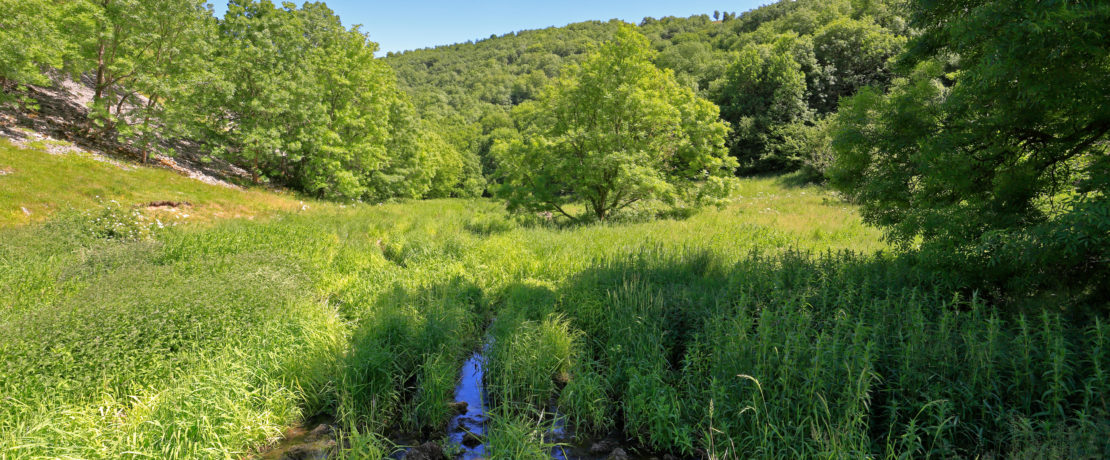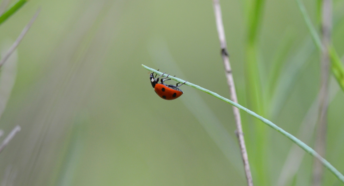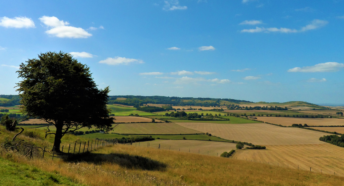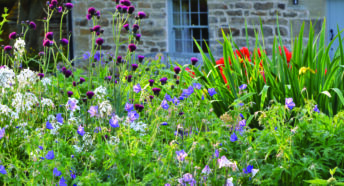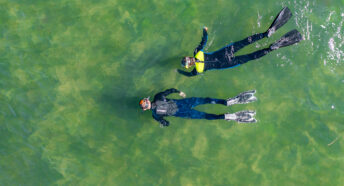Back to the source
Sometimes going back to the beginning can inspire anew. Peter Giles describes how a lockdown encounter sent him on a journey to – so far – the sources of 189 rivers and a renewed connection to the countryside. And he shares his top 10 moments of connection.
It’s 16 November 2020 and the country is struggling with the pandemic. Folk are ‘locked-down’ with limited entitlements to leave their houses. And then – up pops a video clip of one of my family members, Tom, somewhat controversially having taken his daily exercise to the source of the River Dart.
The autumn wind could be heard blowing bleakly over the moor, the sound of (just) trickling water was mesmerising and the sound of a distant curlew and Tom’s excited voice conjured up something truly fascinating which was clearly liberating him, for that moment, from the restraint of the past months. Somehow my experiencing his experience that day created a spark in me which has gone on across nearly two years to become a burning fire of wonderment, adventure and joy.
Connection
How witnessing Tom’s video clip led to me having explored now 189 river sources is difficult to understand but his journey touched on several passions of mine.
The chance to paw over and lose oneself in maps, the opportunity to visit the open spaces of our beautiful countryside where the air is cleanest and the water (mostly) at it sweetest and to be able to blend and merge, all be it too briefly into the natural world – frequently in the company of a feathered orchestra – all came together as the spark became a flame and a new me was kindled. And, of course, the chance to escape from lockdown misery.
Also, one of my loves is cycling. It helps me connect with the countryside both physically and spiritually — and at that time my daily exercise involved various not-very-stimulating circuits around my home town, Barnsley. To be able to marry the growing desire to follow Tom’s inspirational mini-adventure to my love of cycling began to feel like a portal to possibilities.
Where to first?
Out came the local Ordnance Survey map and after what seemed like several hours lost in mindful distraction, the source, the start, the beginning of the River Dearne became my target.
A ride along the Trans Pennine Trail towards Penistone, a climb out of Thurlstone to the Royd Moor view point near the whirling wind turbines and then, with reservoirs in the valley to the right, along the undulating road to Rusby Wood above Birds Edge took me to a somewhat disappointing ditch adjacent to a regimented copse trickling anonymous water away to the Don at Mexborough and beyond.
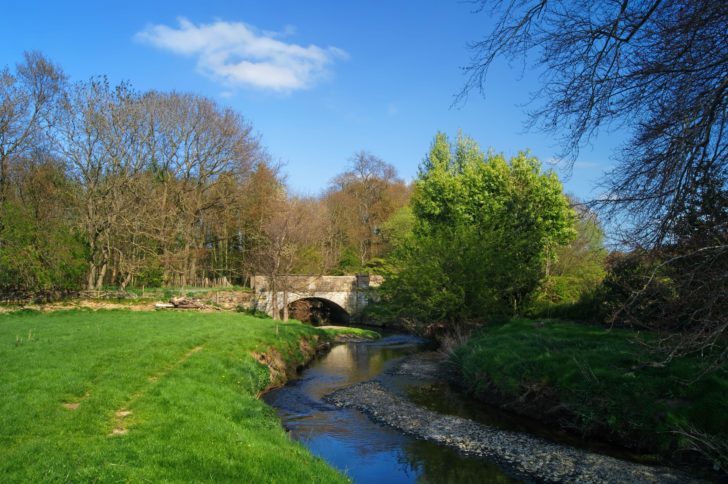
Undeterred, I followed a long unused path parallel to the ditch. Hiding my bike in the undergrowth, I approached a row of ancient beech trees and a stone wall with a stile. And there….
A Pennine meadow pond with water gently entering it along an eroded rill, draining the surrounding pastureland and leaving at the other end along the previously, unfairly, maligned ditch. The weather was there, wind driving rain horizontally, the sky was grey as only November skies can be and I had my very own curlew. I sat on a stone that seemed to have been placed there just for me and I ate my cheese sandwich and banana and drank my energy drink. I felt like I had entered a little piece of paradise. I had escaped.
My journey home was swift, embracing excitedly the idea of ‘this being a beginning of something huge’. I was desperate to find my next source.
I have since visited Dearne Head pond on a number of occasions. It is a place of old, beech trees, nesting wildfowl, lilies and peacefulness. And curlews live there. It is where this ongoing, new and special connection with the countryside began.
Further afield
The Don, the Holme, the Rivelin, the Loxley, the Porter, the Went, the Poulter, the Torne and others were all within cycling distance and permissible within lockdown as regulations ebbed and flowed. Soon longer journeys were demanding to be made, taking me to all the English counties – apart, so far, from my birth county of Sussex.
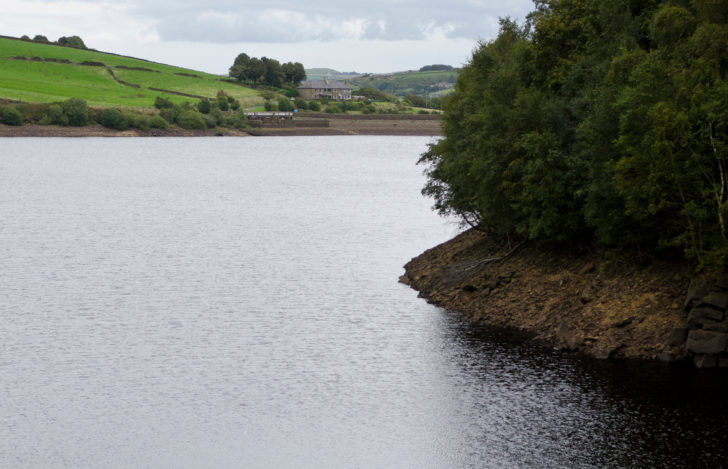
Each source I’ve found to date is special. The landscape, the ease/challenge of finding, the people I met, the sounds of different bird song across the seasons and how close I got on two wheels all contribute to my sense of my happiness at that place and time.
Here are 10 of my ‘happiest’ (to date), and why.
Ten sources of joy
1. River Bovey, Devon
The Bovey in Devon rises on the eastern side of Dartmoor, becoming the biggest tributary to the Teign. There are thought to be two sources but I picked East Bovey Head, near Shapley Tor. I cycled from my brother’s organic farm in Totnes in sunshine, with duelling buzzard and crows, enjoying crystal clear water to quench my thirst (supplemented with a pint at an excellent hostelry on the way home).
2. River Cocker, Cumbria
The Cocker might make its way to Cockermouth but its source is in the Lake District’s fells. Reaching its source at the head of the Buttermere valley, gave me an exquisite hill climb out of Buttermere with stonechats for company.
3. River Dove, Staffordshire and Derbyshire
The Dove rises in the Staffordshire Peaks and finding that sources gave me an excellent ride out of Buxton towards Axe Edge Moor with the first snow of the winter. Absolute tranquillity.
4. River Chew, Somerset
The Chew rises in Somerset’s Mendip Hills. The river just bursts forth from beneath an ancient tree in ancient woodland near Chewton Mendip.
5. River Hodder, Lancashire
Lancashire’s Hodder wends its way through the Forest of Bowland AONB to give total quiet and unbelievable views from White Hill after a fantastic ride.
6. River Meon, Hampshire
The Meon in Hampshire, a chalk stream famous for its watercress beds, surfaces in East Meon in the South Downs. It was a joy to find it on a misty, midsummer morning while riding the King Alfred’s Way with my brother.
7. River Lathkill, Derybshire
Derbyshire’s Lathkill, with its source at Lathkill Head Cave near Monyash in the Peak District brings forth the purest, limestone-filtered water in a wonderful dale just gushing out of a gap in a rockwall – and sweet memories of a sweetheart.
8. River Aln, Northumberland
Following the Aln in Northumberland’s Cheviot Hills gave me a ride to a remote place where dreams came true – or at least my dream of climbing big hills on my bike to the clean air and wonderful views. The source of the Aln at Alnham gave me the start of a ride into High Knowes which is truly high up in the Cheviots – a ride through a dream world for me.
9. River Rase, Lincolnshire
The Rase rises on Bully Hill in the Lincolnshire Wolds, giving me a bit of a surprise as I clambered up the hill and found a large meadow pond replete with wildfowl lying below the ravine containing the river’s source. An encounter with a gamekeeper was a surprise for us both – initially he was rather suspicious at my presence and then friendly as he warmed to my mission and walked into the ravine with me to show off ‘his’ river.
10. River Leven, North Yorkshire
The Leven, winding its way down from the North York Moors near Kildale, gave me a ride into the clouds and wide open space hosting whirling lapwings (and more curlews).
And onwards
Initially my adventure was very much about desperate but legitimate escapes to hill and dale, moor and woodland, where the stresses of the pandemic were eased. Now it continues further, less fettered into the world of burns and becks, cloughs and ghylls, grains and winterbournes, springs, dikes, rills, hopes and sykes – always with maps and care of risk. And one thing that I have learned is that you can step over a brook but to cross a stream dry footed, you have to leap.
Where to from here? Towards 250 and initially to Sussex, the Ouse, the Rother, the Arun, the Cuckmere and the rest. Enjoy your escapes to the countryside, whichever path you take.
